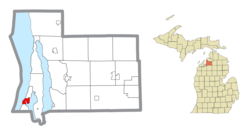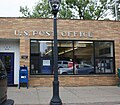2010 census
As of the census [11] of 2010, there were 1,642 people, 791 households, and 478 families residing in the village. The population density was 995.2 inhabitants per square mile (384.2/km2). There were 1,179 housing units at an average density of 714.5 per square mile (275.9/km2). The racial makeup of the village was 96.6% White, 0.7% African American, 1.2% Native American, 0.5% Asian, 0.1% Pacific Islander, 0.2% from other races, and 0.7% from two or more races. Hispanic or Latino of any race were 1.3% of the population.
There were 791 households, of which 21.0% had children under the age of 18 living with them, 48.4% were married couples living together, 9.6% had a female householder with no husband present, 2.4% had a male householder with no wife present, and 39.6% were non-families. 34.8% of all households were made up of individuals, and 17.9% had someone living alone who was 65 years of age or older. The average household size was 2.07 and the average family size was 2.63.
The median age in the village was 52.4 years. 18.6% of residents were under the age of 18; 5.6% were between the ages of 18 and 24; 16.3% were from 25 to 44; 30.9% were from 45 to 64; and 28.7% were 65 years of age or older. The gender makeup of the village was 46.5% male and 53.5% female.
2000 census
As of the census [2] of 2000, there were 1,700 people, 769 households, and 483 families residing in the village. The population density was 1,014.3 inhabitants per square mile (391.6/km2). There were 1,056 housing units at an average density of 630.1 per square mile (243.3/km2). The racial makeup of the village was 97.00% White, 0.29% African American, 1.00% Native American, 0.12% Asian, 0.24% Pacific Islander, 0.59% from other races, and 0.76% from two or more races. Hispanic or Latino of any race were 2.12% of the population.
There were 769 households, out of which 27.8% had children under the age of 18 living with them, 49.7% were married couples living together, 10.8% had a female householder with no husband present, and 37.1% were non-families. 34.6% of all households were made up of individuals, and 17.3% had someone living alone who was 65 years of age or older. The average household size was 2.20 and the average family size was 2.83.
In the village, the population was spread out, with 24.2% under the age of 18, 5.1% from 18 to 24, 23.2% from 25 to 44, 27.5% from 45 to 64, and 19.9% who were 65 years of age or older. The median age was 43 years. For every 100 females, there were 94.5 males. For every 100 females age 18 and over, there were 83.2 males.
The median income for a household in the village was $31,382, and the median income for a family was $45,179. Males had a median income of $30,845 versus $23,167 for females. The per capita income for the village was $19,735. About 7.6% of families and 8.2% of the population were below the poverty line, including 11.1% of those under age 18 and 5.8% of those age 65 or over.















